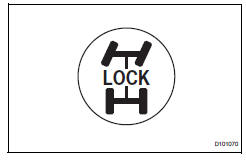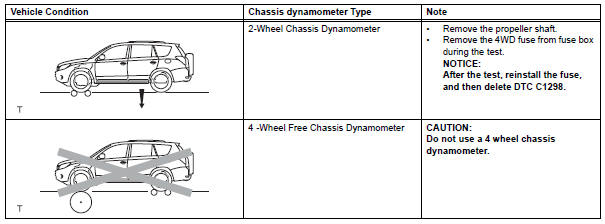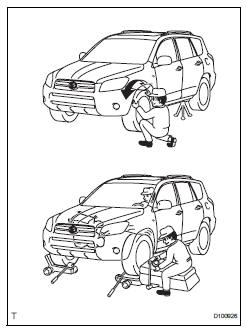Toyota RAV4 (XA40) 2013-2018 Service Manual: When servicing active torque control 4wd vehicles
- The active torque control 4wd rav4 is equipped
with the 4 wheel drive control system.
If incorrect preparations or test procedures are used, the test will not only be unsuccessful, but may be dangerous as well.
Caution:
- Never accelerate or decelerate the vehicle suddenly.
- Observe the other cautions given for each individual test.
Notice:
- Sudden shifting, braking, acceleration or deceleration is not allowed.
- Do not use the parking brake while the vehicle's wheels are rotating.
- Do not perform the measurements continuously for a long period of time.
- Make sure to activate the vehicle stability control (vsc) & traction control (trac) system to an operational condition after the test. Check that the vsc warning indicator light goes off when restarting the engine.
- Therefore, before beginning any such servicing or test, be sure to check the following items:
- Whether the tires are touching the ground or jacked up
- Transmission gear position
- Maximum testing vehicle speed
- Maximum testing time

- When using a braking force tester (not free roller type):
When performing measurements using a low-speed type (vehicle speed: below 0.5 Km/h or 0.3 Mph) brake tester, observe the following instructions.
- Press the 4wd lock-mode switch to off to disable the 4wd system.
- If the vehicle is equipped with the vehicle stability control (vsc) & traction control (trac) system, prohibit the system from activating.

- Position the front wheels to be tested on the tester.
- Jack up the rear wheels.
- Ensure that the vehicle does not move using wires.
- Shift the transmission shift lever to the "n" position.
- Idle the engine, operate the brake booster and perform the test.
Caution:
The maximum driving time should be 1 minute.
- When using a braking force tester (free roller type): when performing measurements using a low-speed type (vehicle speed: below 0.5 Km/h or 0.3 Mph) brake tester, observe the following instructions.

- Press the 4wd lock-mode switch to turn it off and disable the 4wd system.
- If the vehicle is equipped with the vehicle stability control (vsc) & traction control (trac) system, prohibit the system from activating.

- Position the front wheels on the tester roller.
- Position the rear wheels on the free roller.
- Ensure that the vehicle does not move using wires.
- Shift the transmission shift lever to the "n" position.
- Idle the engine, operate the brake booster and perform the test.
Caution:
The maximum driving time should be 1 minute.
- When using a speedometer (not free roller type): observe the following instructions and then measure with the rear wheels.

- Press the 4wd lock-mode switch to turn it off and disable the 4wd system.
- If the vehicle is equipped with the vehicle stability control (vsc) & traction control (trac) system, prohibit the system from activating.

- Position the front wheels on the tester.
- Jack up the rear wheels.
- Ensure that the vehicle does not move using wires.
- Shift the transmission shift lever to the "d" position.
Caution:
- The maximum speed should be less than 50 km/h (31 mph).
- If the measurement is required with over 50 km/h (31 mph), remove the propeller shaft.
- When using a speedometer (free roller type): observe the following instructions and then measure with the rear wheels.

- Press the 4wd lock-mode switch to turn it off and disable the 4wd system.
- If the vehicle is equipped with the vehicle stability control (vsc) & traction control (trac) system, prohibit the system from activating.

- Position the front wheels on the tester roller.
- Position the rear wheels on the free roller.
- Ensure that the vehicle does not move using wires.
- Shift the transmission shift lever to the "d" position.
Caution:
- The maximum speed should be less than 50 km/h (31 mph).
- If the measurement is required with over 50 km/h (31 mph), remove the propeller shaft.
- Using chassis dynamometer


When performing high speed, high load measurements on a chassis dynamometer, observe the following instructions and then measure with the front wheels.
- If the vehicle is equipped with the vehicle stability control (vsc) & traction control (trac) system, prohibit the system from activating
- Ensure that the vehicle is securely fixed in place.
Hint:
- Sudden shifting, braking, acceleration or deceleration is not allowed.
- Make sure to activate the vehicle stability control (vsc) & traction control (trac) system after the test. Check that the vsc warning indicator light goes off when restarting the engine.
- On-vehicle wheel balancing: when performing on-vehicle wheel balancing on an active torque control 4wd vehicle, to prevent each wheel from being rotated at a different speed and in different directions, always be sure to observe the following precautions.

- All 4 wheels should be jacked up and lifted off of the ground completely.
- Press the 4wd lock-mode switch to turn it off and disable the 4wd system.
Caution:
Propeller shaft should be removed.
- If the vehicle is equipped with a vehicle stability control (vsc) system, prohibit the system from activating (see previous step).
- The parking brake lever should be fully released.
- None of the brakes should be applied.
- The wheels should be driven on the wheel balancer with the engine running.
- Carry out the wheel balancing with the transmission in the d position.
Hint:
- When performing the wheel balancing, pay attention to the other wheels rotating at the same time.
- Sudden acceleration, deceleration or braking is not allowed.
- Do not forget to change the vehicle stability control (vsc) system to an operational condition after the test. Check that the vsc warning indicator light goes off when restarting the engine.
 For vehicles equipped with vehicle stability (vsc) system
For vehicles equipped with vehicle stability (vsc) system
Notices when using drum tester
Before beginning testing, disable the vsc. To
disable the vsc, turn the ignition switch off
and connect sst to terminals 12 (ts) and 4
(cg) of the dlc ...
 When towing active torque control 4wd vehicles
When towing active torque control 4wd vehicles
Use one of the methods shown below to tow the
vehicle.
If the vehicle has trouble in the chassis and drivetrain,
use method 1 (flat bed truck).
Notice:
Do not use any towing method ot ...
Other materials:
Light control switch circuit
Description
This circuit detects the state of the headlight dimmer switch.
Wiring diagram
Inspection procedure
Read value of intelligent tester (main body ecu)
Connect the intelligent tester to the dlc3.
Turn the ignition switch on and press the intelligent
tester main switch on ...
Light bulbs
You may replace the following
bulbs by yourself. The
difficulty level of replacement
varies depending on
the bulb. If necessary bulb
replacement seems difficult
to perform, contact your
Toyota dealer.
For more information about
replacing other light bulbs,
contact your Toyota dealer.
Preparing for ...
Parking Support Brake function
(static objects)
If the sensors detect a static object, such as a wall, in the
traveling direction of the vehicle and the system determines
that a collision may occur due to the vehicle suddenly moving
forward due to an accidental accelerator pedal operation, the
vehicle moving the unintended direction due to the wr ...
